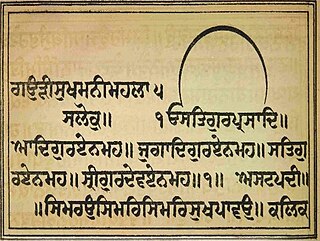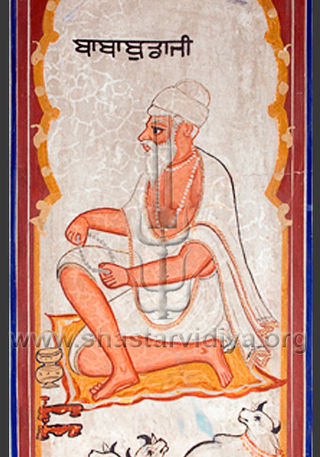Baba Sunder | |
|---|---|
| Personal | |
| Religion | Sikhism |
| Parent |
|
| Known for | Composing Ramkali Sadu |
| Part of a series on |
| Sikhism |
|---|
 |
Baba Sunder, also spelt as Sundar, was one of the four Gursikhs whose gurbani is present in Guru Granth Sahib. [1]
Baba Sunder | |
|---|---|
| Personal | |
| Religion | Sikhism |
| Parent |
|
| Known for | Composing Ramkali Sadu |
| Part of a series on |
| Sikhism |
|---|
 |
Baba Sunder, also spelt as Sundar, was one of the four Gursikhs whose gurbani is present in Guru Granth Sahib. [1]
He was the great-grandson of the third Sikh Guru, Guru Amar Das. [1] His father is said to be Anand Das, and he is the grandson of Guru Amardas' younger son, Baba Mohri. He is said to have had a pleasant childhood and had deep affection for his great-grandfather, Guru Amar Das. [2] [3] [4]
He was known for his composition, Ramkali Sadu , which was composed by him, and is present on Angs (pages) 923–924 of the Guru Granth Sahib. [5] The composition contains six stanzas, or padas. Sadh literally means "call" (ਸੱਦਾ). The hymn states how Guru Amardas has become one with Almighty God and appoints Guru Ramdas as the next guru, and how he told his family not to weep for him after his death. The composition also explains the reaction of a Sikh towards physical death. [6] [7] It also expounds on the importance of kirtan on the spiritual path and describes the nature of the Sikh gurus as different physical bodies embodied by one spirit. [1] It is also one of the earliest surviving literature documenting the death of a Sikh guru, as it testifies that around the time Guru Amar Das died, he anointed Bhai Jeṭhā (later Guru Ram Das) as his successor, placed sandal paste on his forehead (as a mark of passing on the Guruship, and requested that all of his familial relations pay obeisance to him. [1]

Guru Angad was the second of the ten Sikh gurus of Sikhism. After meeting Guru Nanak, the founder of Sikhism, becoming a Sikh, and serving and working with Nanak for many years, Nanak gave Lehna the name Angad, and chose Angad as the second Sikh Guru.

The Guru Granth Sahib is the central holy religious scripture of Sikhism, regarded by Sikhs as the final, sovereign and eternal Guru following the lineage of the ten human gurus of the religion. The Adi Granth, its first rendition, was compiled by the fifth guru, Guru Arjan (1564–1606). Its compilation was completed on 29 August 1604 and first installed inside the Golden Temple in Amritsar on 1 September 1604. Baba Buddha was appointed the first Granthi of the Golden Temple. Shortly afterwards Guru Hargobind added Ramkali Ki Vaar. Later, Guru Gobind Singh, the tenth Sikh guru, added hymns of Guru Tegh Bahadur to the Adi Granth and affirmed the text as his successor. This second rendition became known as the Guru Granth Sahib and is also sometimes referred to as the Adi Granth.

Guru Amar Das, sometimes spelled as Guru Amardas, was the third of the Ten Gurus of Sikhism and became Sikh Guru on 26 March 1552 at age 73.

Guru Har Rai revered as the seventh Nanak, was the seventh of ten Gurus of the Sikh religion. He became the Sikh leader at age 14, on 3 March 1644, after the death of his grandfather and the sixth Sikh leader Guru Hargobind. He guided the Sikhs for about seventeen years, till his death at age 31.
The following outline is provides an overview of Sikhism, or Sikhi.

The Dasam Granth is a collection of various poetic compositions attributed to Guru Gobind Singh. The text enjoyed an equal status with the Adi Granth, or Guru Granth Sahib, in the eighteenth and nineteenth centuries and were installed side by side on the same platform. The Dasam Granth lost favor during the colonial period when reformist Singh Sabha Movement scholars couldn't contextualize the reworkings of Puranic stories or the vast collection of 'Tales of Deceit' Sri Charitropakhyan.

Japji Sahib (Punjabi: ਜਪੁਜੀ ਸਾਹਿਬ, pronunciation: ) is the Sikh thesis, that appears at the beginning of the Guru Granth Sahib – the scripture of the Sikhs. It was composed by Guru Angad, and is mostly the writings of Guru Nanak. It begins with Mool Mantra and then follow 38 paudis (stanzas) and completed with a final Salok by Guru Angad at the end of this composition. The 38 stanzas are in different poetic meters.

Sukhmani Sahib, known under the title of Gauri Sukhmani in the scripture, is usually translated to mean Prayer of Peace is a set of 192 padas present in the holy Guru Granth Sahib, the main scripture and living Guru of Sikhism from Ang 262 to Ang 296. This Gurbani text was written by the 5th Guru, Guru Arjan (1563–1606) at Amritsar in around 1602. Guru Arjan first recited the bani at Gurdwara Barth Sahib in the Gurdaspur district of Punjab, India.

Rehras Sahib, commonly known as So dar Rehras, is the daily evening prayer of the Sikhs and is part of Nitnem. It includes hymns from Guru Granth Sahib Ji and Dasam Granth Ji.

Anand Sahib is a collection of hymns in Sikhism, written in the Ramkali Raag by Guru Amar Das, the third Guru of the Sikhs. It appears on the pages 917 to 922 in Guru Granth Sahib Ji. The word Anand means complete happiness.

Goindwal, also known as Goindwal Sahib and alternatively transliterated as Goindval, is located in the Taran Taran district of the Majha region of Punjab, India about 23 km from Tarn Taran Sahib. In the 16th century it became an important center for the Sikh religion during the Guruship of the Guru Amar Das Ji. Goindwal is on the banks of the river Beas and is one of the focal points of small scale industries of Tarn Taran district.

Bhai Mani Singh was an 18th-century Sikh scholar and martyr. He was a childhood companion of Guru Gobind Singh and took the vows of Sikhism when the Guru inaugurated the Khalsa in March 1699. Soon after that, the Guru sent him to Amritsar to take charge of Harmandir Sahib, which had been without a custodian since 1696. He took control and steered the course of Sikh destiny at a critical stage in Sikh history. He was also a teacher of the Gianian Bunga, later becoming known as the "Amritsari Taksal", currently located in Sato Ki Gali.

The principal Sikh scripture is the Adi Granth, more commonly called the Guru Granth Sahib. The second most important scripture of the Sikhs is the Dasam Granth. Both of these consist of text which was written or authorised by the Sikh Gurus.

Bhagat Sain, also known as Sena Bhagat, was a Hindu mystic poet and saint of the Bhakti movement that lived in the end of the fourteenth and the beginning of the fifteenth century. His name was known in every house due to his devotion to god. Bhagat Sain was a barber of the royal court of Raja Ram Singh, ruler of Rewa. He was a disciple of Ramananda.

Balvand Rai also spelt as Balwand and Rai Balvand, was a poet mystic and rabab player in the court of Guru Arjan.

The Guru Granth Sahib, is the central religious text of Sikhism, considered by Sikhs to be the final sovereign Guru of the religion. It contains 1430 Angs, containing 5,894 hymns of 36 saint mystics which includes Sikh gurus, Bhagats, Bhatts and Gursikhs. It is notable among foundational religious scriptures for including hymns from writers of other religions, namely Hindus and Muslims. It also contains teachings of the Sikh gurus themselves.

Bhattan de Savaiye, also known as Bhatt Bani, is a name given to 123 Savaiyas composed by various Bhatts, which are present in Guru Granth Sahib, scripture of Sikhs. According to various scholars, these Savaiyas are eulogies of first five Gurus of Sikhism.

Baba Buddha was a prime figure in early Sikhism.

Rama, known as Ram Avatar or Raja Ram, is considered an important figure in Sikhism, due to his inclusion as one among the 24 incarnations of Vishnu in the Chaubis Avtar, a composition in the Dasam Granth traditionally and historically attributed to Guru Gobind Singh. The discussion of Rama and Krishna is the most extensive in this section of the secondary Sikh scripture. The composition is martial, stating that the avatar of Vishnu appears in the world to restore good and defeat evil, but asserts that these avatars are not God, but agents of the God. God is beyond birth and death. The famous Savaiya and Dohra from the Rehras Sahib, read daily be devout Sikhs, comes from Ram Avtar Bani. However, it is not to be confused with Sikhs believing or worshipping Raja Ram or Krishan. It is clear from Guru Gobind Singh's verses in Chaupai Sahib, a part of Sikh Nitnem, or daily prayer.

Satta Doom, also spelt as Satta Dum, was a drummer and author of eight verses found within the Guru Granth Sahib.